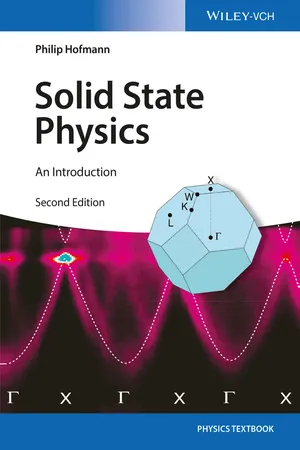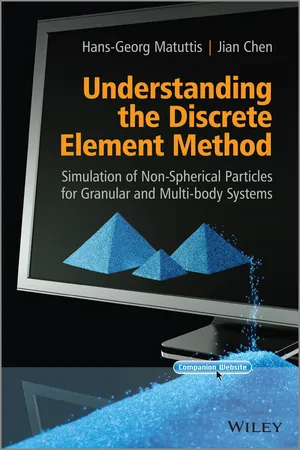Physics
Lattices
In physics, lattices refer to regular arrangements of points or particles in space. These structures are important in the study of crystalline materials and solid-state physics, as they help describe the arrangement of atoms or molecules within a crystal. Lattices play a crucial role in understanding the properties and behavior of materials, such as their electrical, thermal, and mechanical characteristics.
Written by Perlego with AI-assistance
Related key terms
Related key terms
1 of 4
Related key terms
1 of 3
8 Key excerpts on "Lattices"
- eBook - ePub
Characterization of Condensed Matter
An Introduction to Composition, Microstructure, and Surface Methods
- Yujun Song, Qingwei Liao(Authors)
- 2023(Publication Date)
- Wiley-VCH(Publisher)
3 ).Source: From [1] /John Wiley & Sons.3.2.2 Lattice and Crystal Structure
The periodicity of atoms or groups of atoms in crystals can be represented by a number of points that are regularly distributed in space. The distance between adjacent points in either direction is the period of the crystal along that direction. A collection of such points constitutes a spatial lattice, and each point is called a node of the lattice. Since the lattice is only a geometric abstraction representing the arrangement of atoms or groups of atoms, a point in the lattice does not necessarily represent the exact position of an atom. In other words, there may be exactly one atom or a group of atoms at each lattice point. In any case, the environment around each lattice point (including the atom types and distributions) is always the same, i.e. the lattice points are all identical.In mineralogy and crystallography, crystal structure describes a unique arrangement of atoms or molecules in a crystalline liquid or solid. A crystal structure is composed of a pattern, a set of atoms arranged in a particular way, and a lattice exhibiting long‐range order and a characteristic symmetry. Patterns are located upon the points of a lattice, which is an array of points repeating periodically in three dimensions. The points can be thought of as forming identical tiny boxes, called unit cells, that fill the space of the lattice. The lengths of the edges of a unit cell and the angles between them are called the lattice parameters. A crystalline structure is similar to a kind of three‐dimensional wallpaper, an infinite repetition of some entity (such as a series of atoms or molecules). The procedure for creating a pattern consists of performing the point group operations that define it, such as rotation, reflection, and inversion. Making the wallpaper requires a movement (with or without rotation and reflection) to create a lattice that is a complete structure. In practice, crystalline structures can consist of single Lattices or multiple grids to synthesize complex crystalline molecules. As long as it is repeatable, X‐ray diffraction can be used to determine its structure. - eBook - ePub
- A. Srikantha Phani, Mahmoud I. Hussein, A. Srikantha Phani, Mahmoud I. Hussein(Authors)
- 2017(Publication Date)
- Wiley(Publisher)
Chapter 1 Introduction to Lattice Materials A. Srikantha Phani 1 and Mahmoud I. Hussein 2 1 Department of Mechanical Engineering, University of British Columbia, Vancouver, Canada 2 Department of Aerospace Engineering Sciences, University of Colorado Boulder, USA 1.1 Introduction The word “lattice” implies a certain ordered pattern characterized by spatial periodicity, and hence symmetry. In crystalline solids, for example, atoms are arranged in a spatially periodic pattern or a lattice. Such a crystal lattice is specified by a unit cell and the associated basis vectors defining the directions of tessellation [1, 2]. Spatially repetitive patterns are not unique to atomic length scales. They appear over a wide range of length scales, spanning several disciplines and areas of application; see Figure 1.1 for a representative list. Carbon nanotubes [3] and single-layer graphene sheets [4] are periodic materials with nanoscale features. Microelectromechanical systems (MEMS) for radio frequency applications use microscale periodic architectures to form mechanical filters [5]. Biomedical implants such as cardiovascular stents are periodic cylindrical mesh structures [6, 7]. At macro and mega scales, periodic structural construction is widely used in composites in materials engineering [8, 9], turbomachinery in aerospace engineering [10, 11], and bridge and tower structures in civil engineering [12]. Aircraft surfaces typically use a skin-stinger configuration in the form of a uniform shell, reinforced at regular spatial intervals by identical stiffener/stingers. Similarly, rib-skin aircraft structural components, used in tails and fins, comprise two skins (plates) interconnected by ribs [13]. Interested readers are referred to the book by Gibson and Ashby [14] for further studies on lattice materials and the reviews by Mead and by Hussein et al - eBook - ePub
One-Dimensional Metals
Conjugated Polymers, Organic Crystals, Carbon Nanotubes and Graphene
- Siegmar Roth, David Carroll(Authors)
- 2015(Publication Date)
- Wiley-VCH(Publisher)
polycrystalline. They are composed of microcrystalline domains or grains, which stick together to form the bulk solid. The diameter of a grain can be from fractions of a micrometer up to several millimeters.The long-range order in a crystal leads to the crystal lattice. In a crystal lattice, the regular arrangement of the atoms (or molecules) is periodic; the same pattern is repeated over and over again (cf. sodium lattice in Figure 3.2 ; sodium chloride lattice in Figure 3.4 . Three repeating units in each direction are shown.) In order to classify the many different lattice types, their symmetry properties are used. (There are many textbooks of crystallography. However, Ashcroft and Mermin [1] has long been a standard for understanding crystal symmetries at the elementary level.) The Lattices in Figures 3.2 and 3.4 are cubic. A cubic elementary cell, which is a commonly found repeating unit, can be constructed as indicated in bold in the upper right corner. For the sake of clarity, only the atoms at the surface of the crystal are shown while the atoms “inside” are omitted. (Examples of textbooks on crystal structure and chemistry are [4–6].)Crystal lattice of sodium metal.Figure 3.2This first example (Figure 3.2 ) is of a simple cubic system. That is, each site of the mental construct of the lattice (the mathematical arrangement of points in a regular square array) is occupied by an atom to form a real lattice of the solid. The subtlety (and formality) of forming the mental construct first, then filling in with atoms is an important one. After all, we need not imagine only one atom associated with a given site. Consider associating more than one with each site of the square lattice. The picture could get rather complex. The associated group of atoms placed on each lattice site is referred to as a “basis.”The use of a basis set is illustrated in Figure 3.3 - eBook - ePub
Solid State Physics
An Introduction
- Philip Hofmann(Author)
- 2015(Publication Date)
- Wiley-VCH(Publisher)
This chapter is divided into three parts. In the first part, we define some basic mathematical concepts needed to describe crystals. We keep things simple and mostly use two-dimensional examples to illustrate the ideas. In the second part, we discuss common crystal structures. At this point, we do not ask why the atoms bind together in the way that they do, as this is treated in the next chapter. Finally, we go into a somewhat more detailed discussion of X-ray diffraction, the experimental technique that can be used to determine the microscopic structure of crystals. X-ray diffraction is used not only in solid state physics but also for a wide range of problems in nanotechnology and structural biology.1.1 General Description of Crystal Structures
Our description of crystals starts with the mathematical definition of the lattice. A lattice is a set of regularly spaced points with positions defined as multiples of generating vectors. In two dimensions, a lattice can be defined as all the points that can be reached by the vectors , created from two vectors and as1.1where n and m are integers. In three dimensions, the definition is1.2Such a lattice of points is also called a Bravais lattice. The number of possible Bravais Lattices that differ by symmetry is limited to 5 in two dimensions and to 14 in three dimensions. An example of a two-dimensional Bravais lattice is given in Figure 1.1 . The lengths of the vectors and are often called the lattice constants.Example for a two-dimensional Bravais lattice.Figure 1.1Having defined the Bravais lattice, we move on to the definition of the primitive unit cell. This is any volume of space that, when translated through all the vectors of the Bravais lattice, fills space without overlap and without leaving voids. The primitive unit cell of a lattice contains only one lattice point. It is also possible to define nonprimitive unit cells that contain several lattice points. These fill space without leaving voids when translated through a subset of the Bravais lattice vectors. Possible choices of a unit cell for a two-dimensional rectangular Bravais lattice are given in Figure 1.2 . From the figure, it is evident that a nonprimitive unit cell has to be translated by a multiple of one (or two) lattice vectors to fill space without voids and overlap. A special choice of the primitive unit cell is the Wigner–Seitz cell that is also shown in Figure 1.2 - eBook - ePub
- Timothy S Fisher(Author)
- 2013(Publication Date)
- WSPC(Publisher)
Chapter 3 applies equally well to fluid phases. Within the array of solid-state materials, single-crystal structures are the most amenable for initial study, although even these structures become rather complex in three dimensions with various atomic arrangements such as face-centered cubic (fcc), body-centered cubic (bcc), and diamond configurations that are perhaps most familiar to readers. To minimize digression, here we refer the reader to the many excellent textbooks on solid-state physics (Ashcroft and Mermin, 1976; Kittel, 2007) and crystallography (De Graef and McHenry, 2012) for advanced treatment of 3D crystals.We will focus on one- and two-dimensional Lattices for the sake of expediency and because the 2D graphene lattice has high contemporary scientific and technological importance. A simple 1D structure is obtained by repeating the diatomic arrangement of Fig. 1.2 indefinitely. Figure 1.5 shows the resulting configuration, with each atom of mass m connected to its neighbor by a bond with spring constant g. The equilibrium separation between atoms is represented by the lattice constant a. Somewhat surprisingly, this simple, idealized structure will enable us to develop almost all the essential tools for analysis of lattice vibrations and their quantum manifestation—called phonons.Fig. 1.4 (a) Two isolated, self-contained atoms and associated electron energy states. (b) Quantized energy states upon bond formation between the two isolated atoms. Energy levels are modified as electron orbitals become shared in a bond.Because an ideal crystal extends infinitely in all directions, we must find a way to concentrate the analysis on a smaller region. Fortunately, the regular order, or periodicity, of a crystal lattice makes this task straightforward. A primitive unit cell of a lattice is one that, if repeated throughout all space by well-defined translational vectors, would fill the space entirely and with no overlapping regions or void spaces. Figure 1.6 shows an example for a 2D monatomic rectangular lattice. Several possible shapes, positions, and orientations of the primitive unit cell exist for this lattice, as indicated by the shaded regions. The arrows denote basis vectors that define the periodic translation of the unit cells throughout the domain. The set of all possible translations by integer indexing of basis vectors forms a so-called Bravais lattice, whose discrete points are given by the lattice vector - eBook - ePub
Understanding the Discrete Element Method
Simulation of Non-Spherical Particles for Granular and Multi-body Systems
- Hans-Georg Matuttis, Jian Chen(Authors)
- 2014(Publication Date)
- Wiley(Publisher)
3 in three dimensions, and in one dimension there is just the ‘lattice constant’ a). ‘Proper’ crystal structures are constructed with the symmetry, i.e. the unit cell, and the basis, i.e. an internal structure with an arrangement of particles in the unit cell; this construction is sometimes written in mock-equation form aslattice + basis = crystal structure.(a) Tilings with structure resembling crystals, i.e. periodic space-filling partitionings which can be continued to infinity, where the unit cells are shaded in gray. (b)-(d) Partitionings which are not crystal structures because they are: (b) non-space-filling; (c) self-overlapping; or (d) non-periodic (‘quasi-crystal’).Figure 5.1The two-dimensional space Lattices, with particles represented by filled black circles; from left to right, these are the parallelogram, rectangular, rhombic, square and triangular Lattices. The elementary translations (lattice vectors) are shown as dark gray arrows. The unit cell is marked in light gray, and for the square and triangular Lattices, alternative unit cells are drawn which are also primitive cells. Light gray dotted lines indicate the orientation of the crystal planes.Figure 5.2The same unit cell may be combined with different bases. The triangular lattice (rightmost pattern in Figure 5.2 ), the honeycomb structure in Figure 5.4(a) and the Kagome lattice (Japanese for ‘basket-eye’, a pattern that emerges from basket-weaving) in Figure 5.4(b) all have the same triangular unit cell, but the bases are different. In the field of crystallography, unit cells are said to be primitive if there are no smaller unit cells which could be used to form the lattice. The term ‘elementary cell’ is usually used in the sense of ‘primitive cell’, i.e. as a cell spanned by elementary lattice vectors which could not be chosen smaller, while the term ‘unit cell’ means that the lattice can be built up by translation of the cell, but the cell is not necessarily minimal. In Figure 5.3(a) , the area-centered square is not primitive, as the same lattice can be built by repeating a smaller simple square; the hexagonal structure in Figure 5.3(b) is not a ‘proper’ primitive unit cell, as the same lattice can be constructed via the triangular grid. Other Lattices, such as the Bethe lattice in Figure 5.3(c) - eBook - ePub
- Ruslan P. Ozerov, Anatoli A. Vorobyev(Authors)
- 2007(Publication Date)
- Elsevier Science(Publisher)
preserving the cubic symmetry. In a similar manner, the so-called face-centered cubic (FCC) with four atoms in the unit cell is obtained. Copper, for instance, has a FCC structure. Such cells are called cells with basis (or Bravais Lattices).Crystallographic directions are characterized by identity distances (periods), i.e., the shortest distance between identical atoms in a given direction. Parallel crystallographic planes are also identical to each other. The distance between two adjacent planes with indexes h, k, l, or what amounts to the same things, the distance from the origin to the nearest crystallographic plane with the same indexes are called interplanar spacingdh,k,l. Exactly this value falls into the Bragg equation (refer to Sections 6.3.5 ).Periods of Lattices a , b , c together with angles α , β , γ , plane indexes (h, k, l ) and interplanar spacing d are bound by a so-called quadratic form. For the simplest case of a cubic crystal, the quadratic form is presented by the equation(9.1.2)1=d 2.h 2+k 2+l 2a 2(9.1.2)Structure and crystal lattice define the positions of atomic CM in the unit cell. In addition, atoms in crystals perform thermal oscillations, significantly influencing the crystal’s physical properties. These oscillations are characterized by root mean square displacements.The main method of crystal structure determination is X-ray diffraction analysis (refer to Section 6.3.5 - R. E. Smallman, R J Bishop(Authors)
- 1999(Publication Date)
- Butterworth-Heinemann(Publisher)
2.1b , one can appreciate why the structures of comparatively highly-ordered crystalline substances, such as chemical compounds, minerals and metals, have tended to be more amenable to scientific investigation than glasses.2.2 Crystal Lattices and structures
We can rationalize the geometry of the simple representation of a crystal structure shown in Figure 2.1a by adding a two-dimensional frame of reference, or space lattice, with line intersections at atom centres. Extending this process to three dimensions, we can construct a similar imaginary space lattice in which triple intersections of three families of parallel equidistant lines mark the positions of atoms (Figure 2.2a ). In this simple case, three reference axes (x, y, z ) are oriented at 90° to each other and atoms are ‘shrunk’, for convenience. The orthogonal lattice of Figure 2.2a defines eight unit cells, each having a shared atom at every corner. It follows from our recognition of the inherent order of the lattice that we can express the geometrical characteristics of the whole crystal, containing millions of atoms, in terms of the size, shape and atomic arrangement of the unit cell, the ultimate repeat unit of structure.2Figure 2.2 Principles of lattice construction.We can assign the lengths of the three cell parameters (a, b, c ) to the reference axes, using an internationally-accepted notation (Figure 2.2b ). Thus, for the simple cubic case portrayed in Figure 2.2a , x = y = z = 90°; a = b = c . Economizing in symbols, we only need to quote a single cell parameter (a ) for the cubic unit cell. By systematically changing the angles (α , β , γ ) between the reference axes, and the cell parameters (a, b, c ), and by four skewing operations, we derive the seven crystal systems (Figure 2.3 ). Any crystal, whether natural or synthetic, belongs to one or other of these systems. From the premise that each point of a space lattice should have identical surroundings, Bravais demonstrated that the maximum possible number of space Lattices (and therefore unit cells) is 14. It is accordingly necessary to augment the seven primitive (P) cells shown in Figure 2.3 with seven more non-primitive cells which have additional face-centring, body-centring or end-centring lattice points. Thus the highly-symmetrical cubic system has three possible Lattices: primitive (P), body-centred (I; from the German word innenzentrierte ) and face-centred (F). We will encounter the latter two again in Section 2.5.1 . True primitive space Lattices, in which each lattice point has identical surroundings, can sometimes embody awkward angles. In such cases it is common practice to use a simpler orthogonal non-primitive lattice which will accommodate the atoms of the actual crystal structure.1
Index pages curate the most relevant extracts from our library of academic textbooks. They’ve been created using an in-house natural language model (NLM), each adding context and meaning to key research topics.
Explore more topic indexes
Explore more topic indexes
1 of 6
Explore more topic indexes
1 of 4







